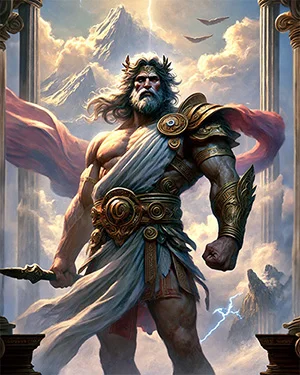Overview
Nyx Goddess of the Night, one of the primordial deities (protogenoi) who emerged at the dawn of creation. Born from Chaos, she personifies the night itself. Nyx’s presence is a fundamental force within the Greek mythological universe, not only because of her own power but also because of her immensely powerful children.
As a child of Chaos, Nyx, coupled with her brother and consort Erebus (Darkness), produced Aether (Light) and Hemera (Day). On her own, she gave birth to a brood of dark spirits, including Hypnos (Sleep), Thanatos (Death), the Moirai (Fates), and Eris (Strife).
Nyx is often seen as the very substance of night—the veil of dark mists covering the sky, hiding the brightness of Aether. Her opposite, Hemera, disperses the mist and darkness at dawn, marking the eternal cycle of night and day. In ancient art, Nyx was depicted as a winged goddess or riding her chariot drawn by her black steeds, sometimes with an aura of dark mists.
Even the most powerful gods, including Zeus, respected Nyx (some say he feared her) and wouldn’t dare oppose her.
Want to know more? Read on…
Watch the related video
Etymology
The name “Nyx” is simply the Greek word Νύξ (Nýx), which directly translates to “night.” This simple yet powerful name captures the essence of Nyx’s domain and influence in Greek mythology. The name reflects her embodiment of the night, a primordial and all-encompassing force in the universe.
Nyx’s name appears in some of the earliest Greek literary works, highlighting her foundational presence in mythological traditions.
The term “Nyx” comes from the Proto-Indo-European root nekwt-/nokwt-, meaning “night,” or negwh-, meaning “become dark.” This root can be found in similar words across many Indo-European languages, such as Latin (nox), Gothic (nahts), Sanskrit (nák), and Lithuanian (naktìs).
Nyx’s name reflects her significance in Greek cosmology, where she represents both the literal and symbolic aspects of the night, encompassing mystery, beauty, and power. Unlike many other deities whose names have various interpretations, Nyx’s name remains direct, embodying the simplicity and depth of the night she governs.
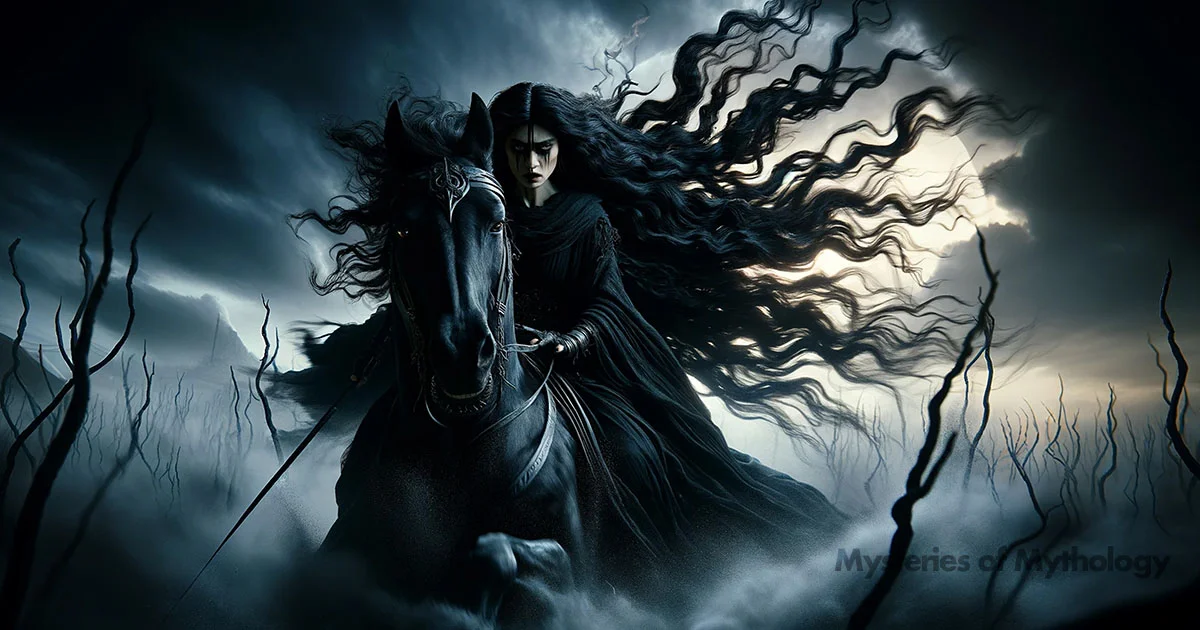
Pronunciation
Pronouncing the name “Nyx” is relatively straightforward, especially for those familiar with Greek phonetics. The name is pronounced as “nicks,” with a short, crisp “i” sound that matches the English pronunciation of “six.”
Pronunciation
ENGLISH
Nyx
GREEK
Νύξ (Nýx)
PHONETIC
[Niks]
IPA
/niks/
Alternate Names
Nyx has been called by various names and epithets that highlight her connection to the night. Names like κελαινή (kelainḗ), μέλαινα (mélaina), and ἐρεβεννή (erebennḗ) all mean “dark” or “black,” showing her link to darkness. Other names like ἱερά (hierá, “holy”) and ἀμβροσίη (ambrosíē, “divine”) emphasise her significance as a goddess.
Some epithets, like ὀλοή (oloḗ, “ruinous”), reflect the fear and awe people felt toward the night. To ease this fear, Nyx was sometimes called Euphrone or Euphrosyne, which means “kindly” or “cheerful.” Such names were used to make her seem less threatening, similar to how the Erinyes, known as the Furies, were also called the “Kindly Ones.”
In Roman mythology, Nyx is known as Nox, which also means “night.” This name change reflects how Roman culture adapted Greek deities while keeping their original meanings and attributes.
Attributes
Mystery and Power
Nyx embodies the mysterious quality of the night, representing the unknown and hidden parts of the universe. Her power is formidable, often described as rivalling that of Zeus, the king of the gods. Whether it was respect or fear, Nyx was the only god or creature whom Zeus dared not oppose, even when in anger. To put this in perspective, Zeus had led the battle and won against the older generation of gods, the Titans, and had fought the most dangerous giant ever created, Typhon, but wouldn’t dare oppose Nyx.
This wasn’t just about physical strength but also about the potential and unknown capabilities of darkness. Homer described her as one who “bends to her sway both gods and men.” In Roman mythology, Nyx is associated with death, magic, and witchcraft.
Beauty and Awe
Nyx is often portrayed as breathtakingly beautiful, draped in dark veils that symbolise the night sky. She’s sometimes imagined wearing a black robe studded with stars or a wreath of poppy flowers. This image reinforces her connection to the stars and her role as a guardian of the secrets within the darkness. Her beauty captures the allure of the night as a time of dreams and introspection.
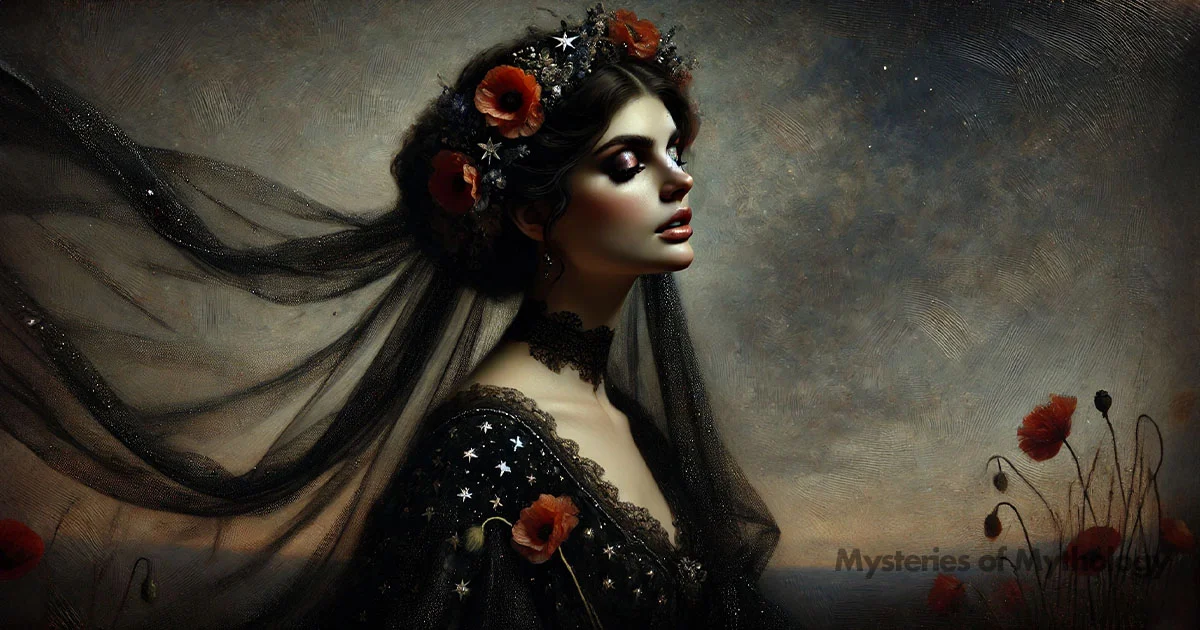
Dual Nature: Protection and Fear
Nyx is a protective force, bringing the comforting embrace of night and rest, but she also inspires fear because of the dangers that might be hidden in the shadows. This dual nature makes her a complex figure, both nurturing and intimidating, reflecting the many sides of the night itself. She embodies the balance between light and dark, showing the natural cycle of day turning into night.
Night and Darkness
Nyx is often depicted with dark, flowing robes or veils that symbolise the earth being covered with night. Sometimes, she’s shown with wings, highlighting her ethereal nature. Nyx rides through the heavens on a chariot drawn by black horses after the sun has finished its daytime journey. She might be accompanied by Sleep, holding the reins, with dreams and stars following her. This imagery highlights her role as the bringer of night and the orchestrator of the celestial dance.
Influence on Life and Death
Nyx’s influence extends to life and death, as her children include Hypnos (Sleep) and Thanatos (Death). She embodies the quiet and reflection that comes with night and the inevitable passage into sleep or death. This aspect of her character makes her a guardian of transitions, whether it’s the daily change from day to night or the final transition from life to death. Her home was said to be in the Underworld, where she lived with her daughter Hemera (“Day”), in a region sometimes considered interchangeable with her consort, Erebus.

Family
Nyx’s family is perhaps why she is considered so powerful, as each of her children has the power to influence other gods and affect the entire continuity of the cosmos.
Nyx was born from Chaos, the original void or abyss that existed before the world was formed. In Hesiod’s Theogony, Chaos is described as the origin of all things, and Nyx emerged from it as a force of darkness and mystery. As such, she does not have traditional parents in the way that Olympian gods do; instead, she is considered a self-created entity that personifies the night.
Nyx’s siblings are other primordial deities who also emerged from Chaos. These include:
- Erebus (Darkness): Often associated with deep shadow and the obscurity of the underworld, Erebus is Nyx’s brother and sometimes her consort. Together, they represent the union of night and darkness.
- Gaia (Earth): The personification of Earth and one of the key figures in creation myths, Gaia is another sibling who plays a crucial role in the genealogy of gods and mortals.
- Tartarus (the Abyss): A deep, dark pit or a primordial deity associated with the underworld’s depths, representing the dark and unfathomable aspects of the universe.
- Eros (Reproduction): Not to be confused with the later god of love, Eros, in this context, is a primordial force of attraction and reproduction, driving the creation and continuation of life and the cosmos.
Nyx’s primary consort is Erebus, her brother and counterpart, with whom she shares a close bond. Their union represents the deep connection between night and darkness, and from their relationship, many other significant deities and entities were born.
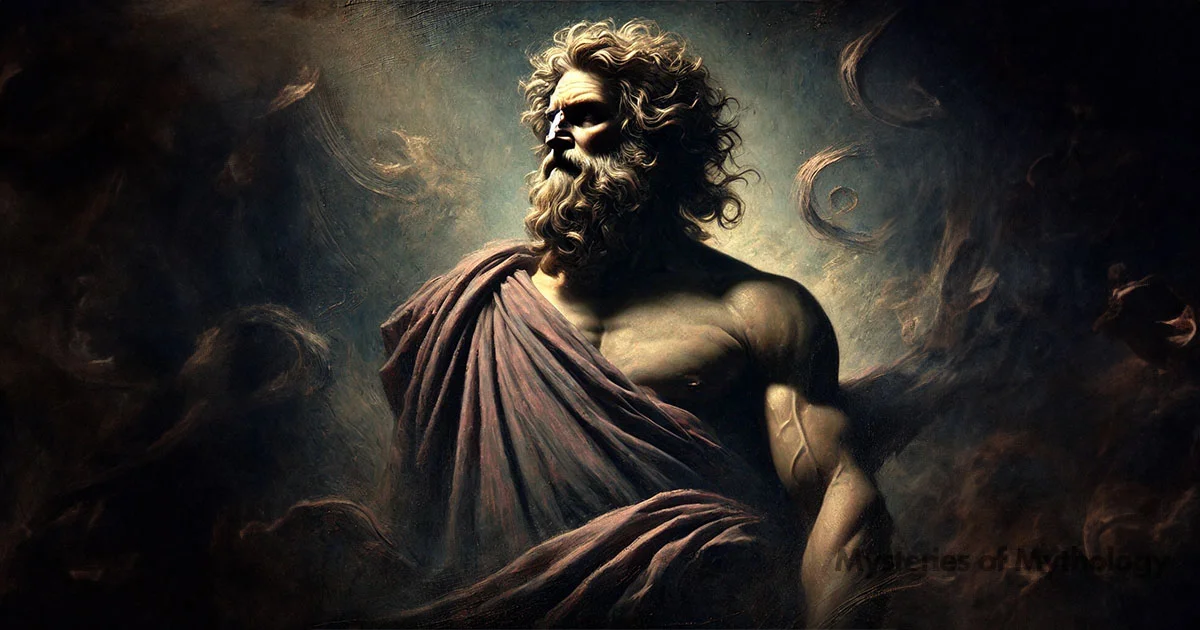
Family Tree
Parents
Father
Chaos
Siblings
brother
Erebus
Consort
Husband
Erebus
Children
Sons
Aether (Light)
Moros (Doom)
Thanatos (Death)
Hypnos (Sleep)
Oneiroi (Dreams)
Momos (Mockery)
Geras (Old Age)
Daughters
Ker (Destruction)
Hemera (Day)
Oizys (Misery)
Hesperides (Evening and Sunset)
Moirae (Fates)
Keres (Violent Death)
Nemesis (Retribution)
Apate (Deception)
Eris (Strife)
Philote (Affection)
Mythology
Nyx didn’t have many stories directly about her in Greek mythology, but her presence was often felt, and she was often referred to in the stories.
She emerged from Chaos, an unfathomable abyss that existed before the world was formed. Chaos was a realm of endless and unpredictable turmoil, and from it came the first primordial deities, forerunners of order and structure. Among these entities, Nyx personified the night, marking the end of chaotic dominion and laying the foundation for the emergence of life.
Nyx wasn’t just about the night; she was a crucial part of the balance between darkness and light. Together with Erebus, she gave birth to a daughter, a son, the god of light, and a daughter, Hemera, the goddess of day. This family represents the cycle of night turning into day and then back into night, highlighting the natural rhythm that governs the universe. Hemera and Nyx both lived in Tarturus, the endless abyss, but were never there at the same time. As the poet Hesiod poetically described,
“Night and Day passing near greet one another as they cross the great bronze threshold. The one is about to go in, and the other is going out of the door, and never does the house hold them both inside…”
Hesiod – Theogony
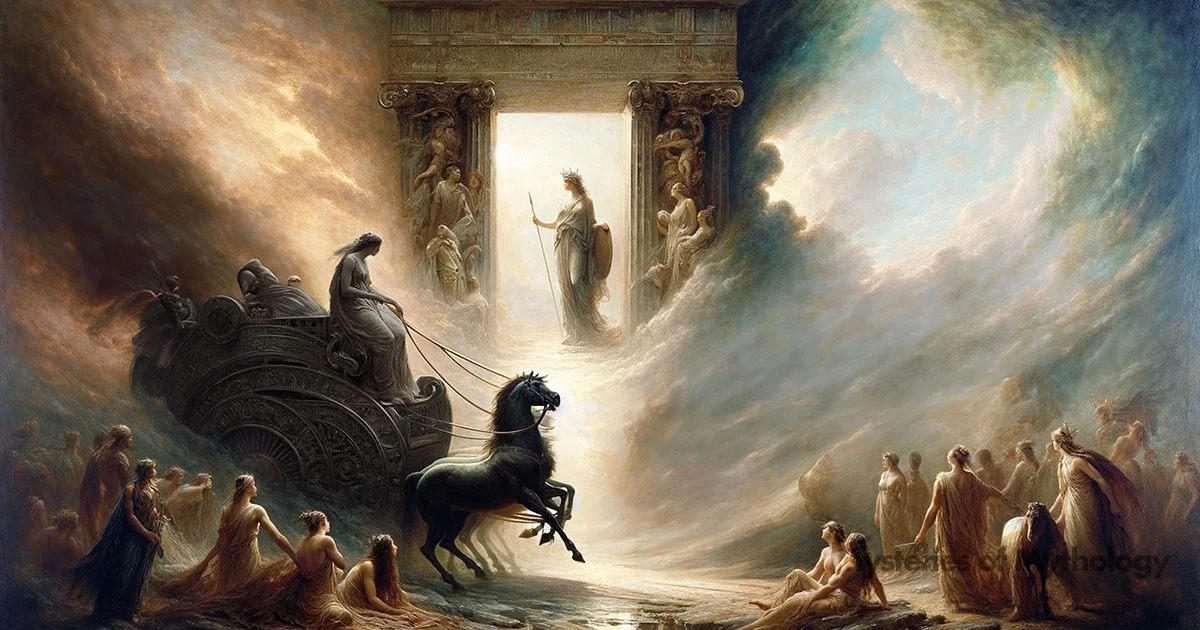
What makes Nyx particularly interesting is the power and respect she commands among the gods. Even Zeus, the mighty king of the gods, hesitated to cross her. There’s a well-known story where Hera, Zeus’s wife, asked Nyx’s son Hypnos, the god of sleep, to put Zeus into a deep slumber so she could carry out her plans against the demigod hero, Heracles.
Hypnos did as he was asked, but when Zeus woke up and realised what happened, he was furious. Hypnos fled to his mother, Nyx, for protection. Zeus, despite his rage, stopped short of confronting Nyx, clearly showing the immense respect and fear he even had for her.
This incident is telling because Zeus wasn’t afraid to take on challenges. He had overthrown his father, Cronus, and led the gods in the epic battle against the Titans. Yet, when it came to Nyx, he backed off. Her power was ancient and formidable, something not even Zeus wanted to mess with.
Nyx’s influence extends through her remarkable children, who each played vital roles in the world and human life. She was the mother of many powerful deities, like Thanatos, the gentle embodiment of death; Moros, who represented fate and doom; and the Oneiroi, dream spirits, including Morpheus. There was also Nemesis, the goddess of retribution, and Eris, the goddess of strife. These offspring had abilities that touched every aspect of existence, from dreams to justice to chaos, showing just how deep Nyx’s influence ran.
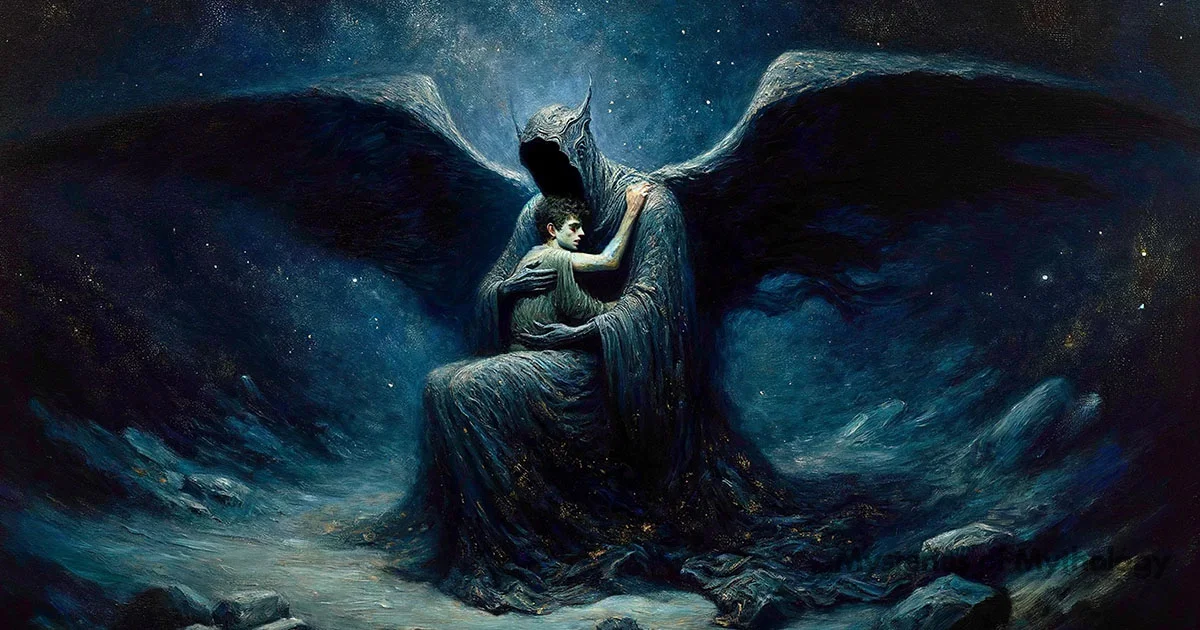
Unlike the Olympian gods, Nyx didn’t need temples or cults to affirm her power. Her presence was felt in the natural cycles of the world and through her children, who could affect the lives of gods and mortals alike. Whether bringing the peaceful embrace of the night or inspiring awe and fear.
Although Nyx does not play a direct role in Homer’s Iliad, her influence is felt through her children, such as Hypnos and Thanatos, who interact with the heroes of the story.
In addition to her role in traditional Greek mythology, Nyx held significant importance in the beliefs of the Orphics, an ancient Greek religious group known for their unique practices and teachings, often referred to as Orphism or the Orphic Mysteries. This spiritual tradition was said to have been founded by the mythical musician Orpheus and presented a different view from conventional Greek religion.
In Orphic theogonies, which are their accounts of the origins of the gods and the cosmos, Nyx was a much more central figure than in the traditional tales told by poets like Hesiod. According to the Orphics, Nyx was often considered the daughter of Phanes (also known as Eros), who was one of the first beings to emerge and the initial ruler of the cosmos. In some versions, however, Nyx herself was the very first being created.
Many Orphic traditions positioned Nyx as one of the early rulers of the cosmos. She eventually passed on her rule to her son, Uranus. Even after stepping down, Nyx continued to play a vital role as a respected advisor from her oracular cave, guiding Uranus and his successors, Cronus and Zeus. In some stories, she even protected and nurtured the Titans, hiding them from the wrathful Uranus.
Worship
Nyx was revered as a Chthonic deity associated with the underworld and the earth. Like other gods of the underworld, offerings to Nyx often involved black animals, with sacrifices typically being burned and buried in enclosed earthen pits. The Greco-Roman poet Statius provides an example of such sacrifices:
“O Nox…ever shall this house throughout the circling periods of the year hold thee high in honour and in worship; black bulls of chosen beauty shall pay thee sacrifice…” (Thebaid).
Outside of her role as a Chthonic deity, Nyx didn’t have as widespread a following as the Olympian gods. However, she did have a small cult following. The ancient traveller Pausanias mentions an oracle dedicated to Nyx at the acropolis in Megara, noting, “you see a temple of Dionysus Nyktelios, a sanctuary built to Aphrodite Epistrophia, an oracle called that of Nyx, and a temple of Zeus Konios.”
Megara, a smaller city-state once tied to Corinth, was known for its temples to Demeter and its citadel, Caria, and had connections to the famed oracle of Delphi.
In Orphic traditions, Nyx played a significant role. The Orphic hymns refer to her as a mother goddess, the source of all life. Orphic fragments also reveal that even Zeus acknowledges Nyx as his mother and as the “highest of the gods,” a title typically reserved for Zeus himself.
Pop Culture
Nyx, the Greek Goddess of the Night, continues to influence modern pop culture, appearing across various media that explore themes of mystery and power.
Nyx appears in numerous fantasy novels and mythological retellings, like Rick Riordan’s Percy Jackson & the Olympians series. In these, she is portrayed as a formidable deity with control over darkness, staying true to her mythological roots.
On screen, Nyx makes an appearance in the TV series Hercules: The Legendary Journeys, where she is depicted as a powerful and mysterious character.
In the gaming world, Nyx takes centre stage as a character in the popular video game Persona 3. Here, she plays a significant role as an antagonist linked to the night and the apocalypse.
Musicians also draw inspiration from Nyx, often referencing her in song titles and lyrics to evoke themes of mystery and transformation. The band Nyx, for example, uses her name to convey a dark, atmospheric sound that reflects her mythological significance.
Visual artists frequently depict Nyx in paintings and digital art, capturing her beauty and enigmatic nature. These artworks often focus on her connection to the night sky and the mysteries she embodies.
Frequently Asked Questions
What is Nyx the goddess of?
Nyx is the Greek goddess of the night. She personifies the night and is a primordial deity representing the mysteries, beauty, and power of the darkness.
Why was Zeus afraid of Nyx?
Zeus feared Nyx because she was a primordial and powerful deity, even older than him. Her ancient power commanded great respect, and Zeus hesitated to challenge her directly, as seen in myths where he refrains from confronting her even when provoked.
Is Nyx good or evil?
Nyx is neither inherently good nor evil. She embodies the dual nature of the night, offering protection and rest but also representing mystery and fear. Her influence encompasses both nurturing and intimidating aspects, reflecting the complexity of the night.
What are Nyx’s powers?
Nyx’s powers include control over the night and its associated phenomena, such as sleep and dreams. She can influence the balance between light and dark, and her presence affects both the divine and mortal realms. Her children, who represent various aspects of life and death, also extend her influence.
Who was Nyx’s husband?
Nyx’s husband was Erebus, the personification of darkness. Together, they produced several significant deities, including Aether (Light) and Hemera (Day), further illustrating the balance between night and day.
References
- Acusilaus, Fragmente der griechischen Historiker
- Aeschylus, Eumenides
- Aeschylus, Prometheus Bound
- Alcman, Poetae Melici Graeci
- Aristophanes, Birds
- Aristotle, Metaphysics
- Bacchylides, Ode
- Cicero, On the Nature of the Gods
- Derveni Papyrus
- Euripides, Andromeda
- Euripides, Ion
- Euripides, Orestes
- Euripides, Heracles
- Epimenides, Diels-Kranz
- Helen Papastavrou, “Nyx,” in Lexicon Iconographicum Mythologiae Classicae
- Hesiod, Theogony
- Homer, Iliad
- Horace, Epodes
- Hyginus, Fabulae
- Nonnus, Dionysiaca
- Oppian, Halieutica
- Orphic Hymn
- Pausanias, Description of Greece
- Plutarch, On the Delays of Divine Vengeance
- Quintus of Smyrna, Posthomerica
- Robert S. P. Beekes, Etymological Dictionary of Greek
- Semni Karusu, “Astra,” in Lexicon Iconographicum Mythologiae Classicae
- Servius on Virgil’s Aeneid
- Sophocles, Electra
- Statius, Thebaid
- Theocritus, Idyll
- Tibullus, Elegies
- Valerius Flaccus, Argonautica
- Virgil, Aeneid
- Ovid, Fasti
- Ovid, Metamorphoses
- Lycophron, Alexandra


